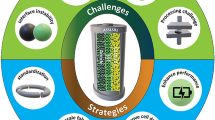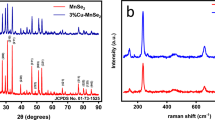Abstract
Rechargeable solid-state batteries have long been considered an attractive power source for a wide variety of applications, and in particular, lithium-ion batteries are emerging as the technology of choice for portable electronics. One of the main challenges in the design of these batteries is to ensure that the electrodes maintain their integrity over many discharge–recharge cycles. Although promising electrode systems have recently been proposed1,2,3,4,5,6,7, their lifespans are limited by Li-alloying agglomeration8 or the growth of passivation layers9, which prevent the fully reversible insertion of Li ions into the negative electrodes. Here we report that electrodes made of nanoparticles of transition-metal oxides (MO, where M is Co, Ni, Cu or Fe) demonstrate electrochemical capacities of 700 mA h g-1, with 100% capacity retention for up to 100 cycles and high recharging rates. The mechanism of Li reactivity differs from the classical Li insertion/deinsertion or Li-alloying processes, and involves the formation and decomposition of Li2O, accompanying the reduction and oxidation of metal nanoparticles (in the range 1–5 nanometres) respectively. We expect that the use of transition-metal nanoparticles to enhance surface electrochemical reactivity will lead to further improvements in the performance of lithium-ion batteries.




Similar content being viewed by others
References
Shodai, T., Okada, S., Tobishima, S. & Yamabi, J. Study of Li 3-xMxN (M = Co, Ni or Cu) system for use as anode in lithium rechargeable cells. Solid State Ionics 786, 86–88 (1996).
Takeda, Y. et al. Lithium secondary batteries using a lithium cobalt nitride, Li 2.6Co0.4N, as the anode. Solid State Ionics 130, 61–69 (2000).
Idota, Y., Kubota, T., Matsufuji, A., MaeKawa, Y. & Miyasaka, T. Tin-based amorphous oxide: A high-capacity lithium-ion storage material. Science 276, 1395–1397 (1997).
Kepler, K. D., Vaughey, J. T. & Thackeray, M. M. LixCu6Sn5 (0<x<13): An intermetallic insertion electrode for rechargeable lithium batteries. Electrochem. Solid State Lett. 7, 307– 309 (1999).
Mao, O., Dunlap, R. A. & Dahn, J. R. Mechanically alloyed Sn-Fe(-C) powders as anode materials for Li-ion batteries. I. The Sn2Fe-C system. J. Electrochem. Soc. 146, 405–413 ( 1999).
Idota, Y. et al. Nonaqueous secondary battery. US Patent No. 5,478,671 (1995).
Sigala, C., Guyomard, D., Piffard, Y. & Tournoux, M. Synthesis and performances of new negative electrode materials for ‘Rocking Chair’ lithium batteries. C.R. Acad. Sci. Paris II 320, 523–529 (1995).
Courtney, I. A., McKinnon, W. R. & Dahn, J. R. On the aggregation of tin in SnO composite glasses caused by the reversible reaction with lithium. J. Electrochem. Soc. 146, 59–68 ( 1999).
Denis, S., Baudrin, E., Touboul, M. & Tarascon, J.-M. Synthesis and electrochemical properties vs Li of amorphous vanadates of general formula RVO4 (R = In, Cr, Al, Fe, Y). J. Electrochem. Soc. 144, 4099–4109 (1997).
Guyomard, D. & Tarascon, J.-M. Rechargeable Li1+xMn 2O4/carbon cells with a new electrolyte composition. Potentiostatic studies and application to practical cells. J. Electrochem. Soc. 140, 3071–3081 ( 1993).
Gozdz, A. S., Tarascon, J.-M. & Schmutz, C. N. Rechargeable lithium interaction battery with flexible electrolyte. US Patent No. 5,296,318 (1994).
Amatucci, G. G., Tarascon, J.-M. & Klein, L. C. CoO2, the end member of the LixCoO 2 solid solution. J. Electrochem. Soc. 143 , 1114–1123 (1996).
Figlarz, M., Fievet, F. & Lagier, J.-P. Reduction process of metal-based inorganic precursors in liquid polyols to produce monodisperse metal particles. French patent No. 8,221,483 (1985).
Buffat, P. & Borel, J. P. Size effect on the melting temperature of gold particles. Phys. Rev. A 13, 2287 –2292 (1976).
Acknowledgements
We thank E. Baudrin, D. Larcher, M. Morcrette, Y. Chabre, G. Amatucci and C. Masquelier for discussions.
Author information
Authors and Affiliations
Corresponding author
Supplementary information
Rights and permissions
About this article
Cite this article
Poizot, P., Laruelle, S., Grugeon, S. et al. Nano-sized transition-metal oxides as negative-electrode materials for lithium-ion batteries. Nature 407, 496–499 (2000). https://doi.org/10.1038/35035045
Received:
Accepted:
Issue Date:
DOI: https://doi.org/10.1038/35035045
- Springer Nature Limited
This article is cited by
-
Impact of gamma irradiation on physico-chemical and electromagnetic interference shielding properties of Cu2O nanoparticles reinforced LDPE nanocomposite films
Scientific Reports (2024)
-
Near-strain-free anode architecture enabled by interfacial diffusion creep for initial-anode-free quasi-solid-state batteries
Nature Communications (2024)
-
Integration of urchin-like MnCo2O4@C core–shell nanowire arrays within porous copper current collector for superior performance Li-ion battery anodes
Rare Metals (2024)
-
Chloride ion batteries-excellent candidates for new energy storage batteries following lithium-ion batteries
Ionics (2024)
-
The reformation of catalyst: From a trial-and-error synthesis to rational design
Nano Research (2024)





